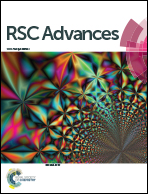Detection of cyanide by a novel probe with a V-shaped structure based on aggregation of the probe adduct†
Abstract
2-[2-[4-(Dimethylamino)phenyl]phenylethenyl]-1,3,3-trimethyl-3H-indolium iodide, a turn-on fluorescent probe for detection of the cyanide anion in aqueous solution with a novel V-shaped structure, is synthesized and characterized. Due to the considerably localized HOMO and LUMO on different “arms” of the probe, its fluorescence is completely quenched in aqueous solution caused by a strong ICT effect and intramolecular rotation of dimethylaminophenyl. However, the emission is dramatically intensified over 500 times when the probe is exposed to cyanide anions and the turn-on fluorescence should be ascribed to the aggregation of the probe adduct in aqueous solution. The probe, which displays a high selectivity and sensitivity for CN− against other analytes, can finish the response within 20 s and the detection limit is measured to be as low as 55 nM. These merits make our cyanide probe one of the most effective ones ever reported.


 Please wait while we load your content...
Please wait while we load your content...